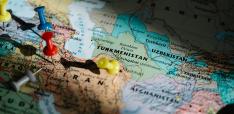The “Snapback” of UN Sanctions amid Iran’s Strategic Perplexity (Part II)

Ali Fathollah-Nejad and Isabella Krämer explore Iran’s narrative of defiance in response to the reimposition of “snapback” sanctions. Read Part I here.
With the reimposition of “snapback” sanctions, Iranian lawmakers have been floating possible responses. Crucially, a proposal for the Islamic Republic’s withdrawal from the Nuclear Non-Proliferation Treaty (NPT) may be gaining some traction. According to statements made by Hossein-Ali Haji-Deligani, a hardline MP, a corresponding bill had been finalized and was bound for presentation to Parliament. Haji-Deligani claimed that a withdrawal from the NPT was “the best option against European actions”.
Additionally, 71 Iranian MPs signed a letter to the Supreme National Security Council (SNSC) - an élite decision-making body tasked with core regime-security interests - and the heads of the three branches of government, urging authorities to consider developing a nuclear weapon as a deterrent. The lawmakers contended that although deploying nuclear weapons would violate a purported 2010 religious decree by Supreme Leader Ali Khamenei banning their use, “manufacturing and maintaining them as a deterrent is a different matter”, citing major shifts in the international security landscape.
Strategic perplexity
However, there is a factional divide within Iran’s establishment over how to respond to the reinstitution of “snapback” sanctions, which highlights the Islamic Republic’s post-war strategic perplexity, a key factor behind its present conundrum. While hardliners are pushing for rapid nuclear weaponization, the so-called moderates caution against actions that could provoke international retaliation. Ali Khamenei’s statements regarding the prospect of Iran acquiring nuclear weapons illustrate his usual strategy of strategic ambivalence with delicate issues: he simultaneously ruled out nuclear weapons “for the time being and in the future” and rejected rapprochement with the U.S. “for at least another 30 years”. In doing so, Ali Khamenei avoided fully satisfying either faction, signaling restraint while maintaining credibility with hardliners. Yet, this posture also underscores a broader paralysis within the post-war Islamic Republic, where strategic questions are constrained by competing political pressures and serious questions persist over whether Ali Khamenei’s authority carries the same weight as before the war. In fact, hardliners’ calls for aggressive nuclear policies and leaving the NPT could well invite renewed Israeli and/or U.S. military strikes against Iran. As such, from a pragmatic standpoint, neither nuclear armament nor withdrawal from the NPT is likely to be implemented, as the short-term costs are too high. In this vein, hardline rhetoric appears to be testing ideas rather than a blueprint for action, reflecting the regime’s constant navigation between ideological dogmatism and political pragmatism.
Parallel to this, Iran is still grappling with its military humiliation during the 12-Day War, pressing ahead with rebuilding its missile program as a deterrent and regional leverage, particularly in light of fears of renewed military escalation with Israel. Additionally, logistical and technological challenges, compounded by reimposed UN sanctions, create urgency. Reports from just a few days ahead of snapback indicated that Tehran was actively seeking planetary mixers, specialized machines critical for missile fuel production, which it hopes to procure from China.
Constrained by sanctions and post-war strategic perplexity, Iran is likely to continue rebuilding its military capacity with the aid of its precarious partners Russia and China. This combination of internal division, attempted military rebuilding, and cautious navigation of external pressures reflects a regime striving to recover from its strategic paralysis while rebuilding its capacity to deter adversaries, however without its decimated regional “Axis of Resistance”.
Tehran claims economic resilience amid ever-deepening crisis
Even before UN sanctions “snapped back” into place, Iran’s ailing economy was highly sensitive to these developments. On September 21, the U.S. dollar rate had skyrocketed to 1,060,000 rials, rising by more than 30,000 rials from September 20 and reaching an unprecedented level just a week before UN sanctions resumed. By September 24, the value of the rial against the U.S. dollar had plummeted further, reaching a trading rate above 1,070,000 rials. Similarly, gold-coin prices had risen by 3.5% to 1,070,000,000 rials, reflecting heightened demand to protect against inflation and currency fluctuation.
Amid this new low in the country’s persistent economic crisis, Iranian officials are floating measures such as coupons or ration cards to hedge against the population’s eroded purchasing power due to a devalued currency and skyrocketing inflation. According to President Masoud Pezeshkian, “[i]ssuing coupons will help low-income workers afford essential items”.
Meanwhile, the Governor of the Central Bank of Iran (CBI), Mohammad-Reza Farzin, attempted on September 22 to calm business concerns. Addressing a state-affiliated business assembly, Farzin insisted that the CBI retains “full security and access” to its foreign currency and gold reserves held abroad. He added that the CBI was preparing measures to help exporters, widen access to hard currency, and open new financing channels, while also introducing financial instruments such as chain financing, gold-backed bonds, and pre-sold foreign currency contracts to bolster market resilience.
In this vein, Oil Minister Mohsen Paknejad downplayed the impact of sanctions on the country’s energy sector, claiming that the measures would not create “new burdensome restrictions” on Iran’s crude exports, signaling confidence that oil sales, especially to China, will continue. A month ago, Paknejad suggested that Iran’s oil sector possessed the expertise to circumvent restrictions on crude sales, highlighting that production capacity had grown by an average of 127,000 barrels per day (bpd) over the past year. When asked about the potential impact of the “snapback” mechanism on Iran’s oil exports, he noted back then that the Islamic Republic had long dealt with sales limitations. “This experience has equipped the oil industry with the skills needed to overcome such obstacles”, he explained. The minister added that specialized teams were ready to adjust strategies in response to any new sanctions. While acknowledging that “snapback” could create additional challenges, Paknejad emphasized that Iran will take the necessary measures to maintain exports. He further stated that Iran planned to boost output to 4.58 million bpd by the conclusion of the Seventh Development Plan (2022–2026). In fact, according to the International Energy Agency (IEA), Iran’s crude oil production climbed by about 200,000 bpd in July, reporting that the country’s output had reached 3.27 million bpd. And in early September, according to the head of the National Iranian Oil Company (NIOC), Iran’s crude oil production reached its highest level in seven and a half years.
Moreover, the swift depreciation of the rial underscores how deeply economic vulnerability is intertwined with Iran’s geopolitical turbulence. The return of UN sanctions, combined with the ongoing U.S. “maximum pressure” sanctions, is set to exacerbate Iran’s economic fragility and put additional pressure on Iranian households. In the short-term, a further collapse of the rial and a sharp rise in inflation is likely, as markets react to diplomatic isolation. Additionally, the regime is likely to face a heightened shortage of hard currency, particularly as oil exports become increasingly difficult to maintain and would have to be offered illicitly at a steeper discount.
In this context, Tehran’s immediate priority appears to be containing domestic unrest, as mounting financial strain and social discontent threaten to destabilize the post-war Islamic Republic. The return of sanctions could intensify these pressures, amplifying public dissatisfaction while constraining the government’s ability to stabilize markets or deliver tangible economic relief.
Initiatives such as coupons or ration cards are unlikely to meaningfully relieve the severe economic pressure that Iranian households have been enduring. At best, and if properly designed, these measures could provide temporary relief. In any case, they are unlikely to address the underlying issues of currency collapse, inflation, and shortages of essential goods. In other words, such programs won’t shield the regime from public backlash, as citizens grow disillusioned and cognizant of the fact that these gestures do not alleviate their day-to-day economic grievances.
At the same time, the practical impact of renewed sanctions on Iran’s oil exports may be uneven. While some Asian buyers could be deterred, China, Iran’s most significant buyer, will most likely continue importing Iranian crude oil. In this vein, Reuters reported that Chinese refiners may secure Iranian oil at steeper discounts, weakening the overall efficacy of the “snapback” measures. In this sense, while sanctions are likely to increase economic malaise, they may also create opportunities for Tehran’s trading partners to exploit Iran’s vulnerabilities.
Conclusion
The reimposition of “snapback” sanctions constitutes an adverse scenario for Tehran, regardless of how confident it seeks to present itself. The reimposition of “snapback” sanctions both exposes and exacerbates the Islamic Republic’s historic economic, military, and regional weakness that has become even more pronounced in the aftermath of the 12-Day War. Having failed to avert the sanctions “snapback”, Iran finds itself short of viable options and paralyzed by its strategic perplexity. Its efforts at military rebuilding remain constrained by technological gaps and reliance on precarious partners, while regionally, the erosion of its “Axis of Resistance” weakens Iran’s ability to put pressure on the West, not least on the negotiation table. Economically, renewed sanctions accelerate the rial’s collapse, accelerate inflation, and risk further societal unrest. With sanctions now reinstated and no favorable options in sight, Tehran confronts an increasingly narrow and costly path forward.
Ali Fathollah-Nejad Director, Center for Middle East and Global Order (CMEG).
Isabella Krämer, Junior Fellow, CMEG.
Photo by Lara Jameson


